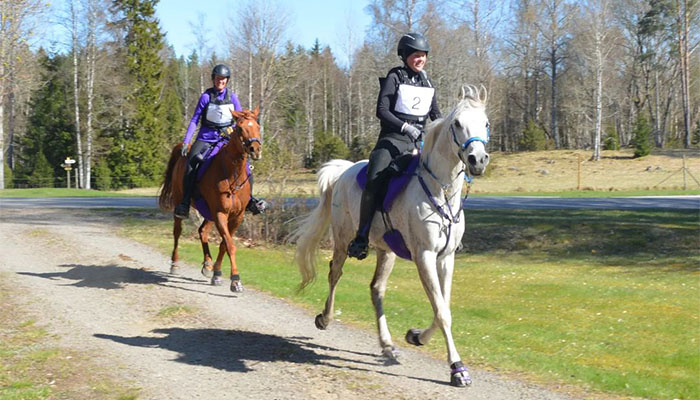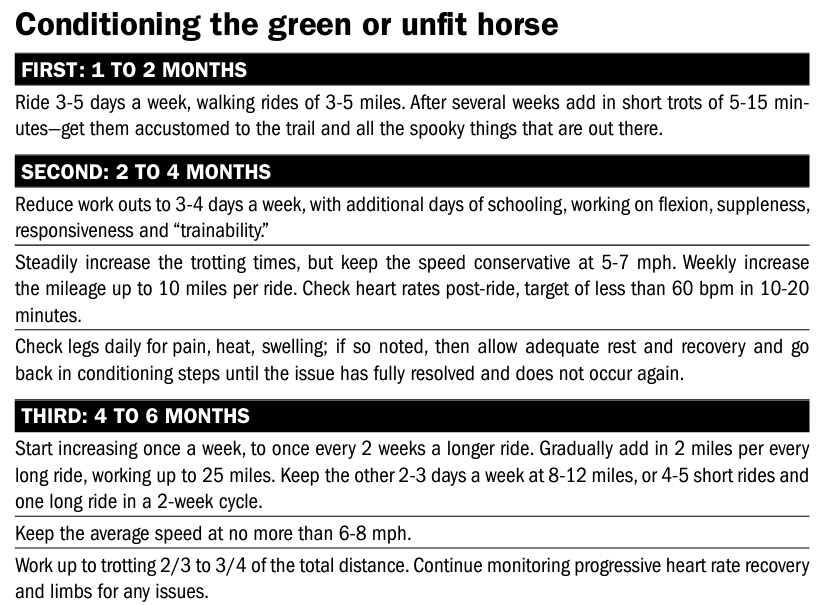
Many equestrians love heading out to the trails with their horses and exploring the countryside. Besides allowing them to take in new scenery on horseback, it also gives them the opportunity to build their relationship with their horse. While this is enjoyable on its own, some equestrians like adding the element of competition to their trail riding experience. This has led to the rise of endurance riding and competitive trail riding, where equestrians are able to put the fitness of their horses and themselves to the test.
Please note: While we use the generic term “horse” throughout this article, horses, ponies, and mules are all frequently seen competing in endurance riding and competitive trail riding.
What is Endurance Riding?
Endurance riding is the ultimate trial for both equestrians and equines. In these races, horse and rider combinations compete over varied terrain on 25, 30, 50, and even 100-mile courses. Periodically throughout the course, the teams are stopped at vet stations where the horse’s physical well-being is evaluated. Horses are held at these checkpoints until their temperature, pulse, and respiration (TPR) return to a normal level, while they monitor for any other signs of distress. After they are cleared, the teams return to the race and continue on through the course.
In an endurance event, there are no minimum times for completion, and the fastest team wins. For horses to do well in this event, many riders predominately trot the race, with brief walking breaks to allow their heart rates to slow prior to the vet checkpoints. Endurance riding involves extreme attention and dedication to your horse’s fitness prior to the event so that they are able to “pulse out” as quickly as possible (pulsing out means returning to normal TPR levels).
Endurance riding is sanctioned by the International Federation for Equestrian Sports (FEI), with competitions being held around the world. According to the FEI, “The sport of endurance is a long-distance competition against the clock. It tests the speed and stamina of both horse and rider, and challenges each combination to ensure effective use of pace and navigational skills over undulating terrains. Endurance is the ultimate test of the partnership between horse and rider. Mandatory vet checks and rest periods are a key aspect of the competition and ensure horse and rider welfare.” In the United States, the American Endurance Ride Conference is the governing body, with over 700 rides being held annually.
What is Competitive Trail Riding?
Competitive trail riding (CTR) is a bit different from endurance riding. Instead of a race against the clock, CTR challenges the rider to complete the course within a window of optimal time, with points being removed for being too fast or too slow on the course. Additionally, judges score the horse and rider combinations on a number of different factors, including condition, soundness, trail manners, and way of going.
Just like endurance riding, CTR horses are stopped at checkpoints along the trail to assess the horse’s fitness and wellness. The teams are held there until the horses have recovered, and then they are allowed to continue through the course. The horses are scored by the judges at the checkpoints as well, receiving points for being well-conditioned for the ride. At the end of the ride, the winner is the horse and rider combination who has received the most points on their scorecard over the duration of the ride.
CTRs are sanctioned by the North American Trail Ride Conference. Generally speaking, CTRs tend to be a bit shorter than endurance rides, with 20, 25, and 50-mile rides being the most popular. The 50-mile rides are held over two days so that the conditioning of the horses can be judged.
How do I get started?
Getting started in endurance riding and CTR is easy! Any equestrian with good riding skills, a sound horse, and a dedication to their fitness can get started. Just like beginning an exercise routine, you will want to start slowly and consistently as you and your horse build both muscle and stamina.
Locate a trail where you can work on varied terrain and increase general fitness levels. Begin by walking (briskly and with a purpose!) and then gradually incorporate trotting into your training regime. As you and your horse become comfortable, you can increase the distance of your rides. Just as you would with your own running or jogging program, you will want to include rest days in your schedule as well as shorter recovery rides. Be sure to assess your horse’s condition on a regular basis, checking their legs for swelling and their muscles for signs of general soreness. Allow your horse to be your guide as you build your partnership together and work toward your goal of longer rides.
Be sure to continue to assess saddle fit as your training progresses, because your horse’s back shape may change as they develop more fitness. A well-fitting saddle ensures that your horse stays comfortable throughout your rides. Many riders use endurance saddles, Australian saddles, all-purpose saddles, and dressage saddles because they are comfortable for both horse and rider. The Wintec Pro Endurance Saddle with HART, the Tucker T59 Endurance Trail Saddle, and the Wintec Pro Stock Saddle with HART are both very popular with endurance riders and competitive trail riders, with their multitude of dee-rings you can use to clip on your equipment.
It is a great idea to keep a journal of your rides so that you can track your progress. Wear a watch during your ride, so that you can develop a slow and steady conditioning plan that gradually increases the distance and time of your rides.
According to Jeanette (Jay) Mero, DVM endurance riders should plan to take utmost care in slowly building fitness. In her article, Preparing Your Horse for the (Crazy-Fun) Sport of Endurance Riding, shared courtesy of the American Endurance Ride Council, she presents the following guide to beginning the conditioning process:
When you feel ready to enter a judged ride, many equestrians start with a CTR. This will help you assess your horse’s fitness levels while also understanding how they will react in a new environment. Remember to go slow and enjoy the journey of distance riding!
What will I need?
When you begin a new riding discipline, you may find that you need additional pieces of equipment… endurance riding and competitive trail riding are no different! You will be riding in all weather conditions, so consider tack that can handle rain and mud, such as synthetic, beta, nylon, or biothane options from Wintec, Weaver, and Zilco. If are looking to begin training for these sports, we recommend having the following on hand:
- Comfortable, Well-Fitting Saddle
- Wicking Saddle Pad
- Bridle (Bitless Bridles are very popular)
- Chafe-free Girth
- Breastplate
- Saddle Bags
- Water Bottle Holder
- Unbreakable Water Bottle
- Appropriate Hoof Boots
- Leg Protection, if desired
- Endurance Sponge
- Well-Ventilated Helmet
- Performance Riding Tights
- Technical Equestrian Shirt
- Well-Fitting Riding Boots or Riding Sneakers (the Ariat Women’s Terrain Waterproof Boot are popular)
- Half Chaps
- Anti-Chafing Powder (such as Lady Anti Monkey Butt)
- Sport Watch/Stopwatch
- Electrolytes
- Sunscreen
- Bug Spray
- Fly Spray
- Ear Net or Riding Fly Mask
- Liniment and Poultice for Post-Ride Recovery

At The Cheshire Horse, we carry a large selection of trail riding supplies. Whether you are a veteran endurance rider or just beginning your training journey, we carry everything you need to saddle up, hit the trails, and enjoy the ride! If you have any questions about any of the endurance and CTR tack and equipment that we carry, we invite you to reach out to a member of our friendly and knowledgeable sales staff.
